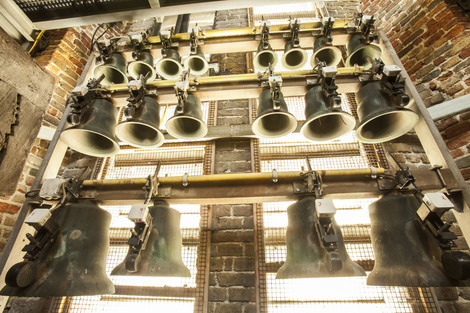The bells! The bells! Struck by metal clappers connected to baton keys, this beautiful sounding word – and a-peeling historic instrument – comprises, by definition, a minimum of 23 cast bronze, cup-shaped bells played melodically or in chords. Usually found in a bell tower or belfry, a carillon is not merely a collection of bells pulled by campanologists yanking on ropes, but a cleverly constructed mechanism that requires no shortage of skill and also brute force the the player, known as the carillonneur or carillonist. First, the big, stick keys, or batons, are heavy work, banged with the fists or played via foot pedals arranged in keyboard form. These are in turn connected to wires and levers that trigger the metal clappers. Fewer than 23 bells? In that case it's not a carillon but a chime.
Written in manuscript, carillion music follows treble and bass clef lines, sometimes several bells sounding at the same time, but more often in quick succession to create a melody line. Each of of the 23 bells are tuned differently across four to six octaves in range. While sounding timeless on its own, the carillon is often too unwieldy and loud to accompany other instruments other than some other background sounds to support it. Here's an example:
But the most famous early carillon is in Mechelen, Belgium, dating back to the 16th century in the tower of St. Rombold’s Cathedral where the first carillonneur was appointed::
Bells are difficult to tune, giving off a complex, reverberant sound, but the instrument reached new standards thanks to the skill of foundry owners François and Pierre Hémony of the Netherlands, who particularly revolutionised inner tunings. Naturally bells have chimed in and out of fashion as an expensive and difficult item to create. The carillon declined in the early 19th century, but made a comeback towards 1890 with pioneering work the John Taylor and Company foundry in Loughborough, Leicestershire. In 1922, the carillon was introduced to the US, where the world's largest featuring 72 bells, were built in each with 72 bells, were built at the Riverside Church in New York City and for Rockefeller Chapel at the University of Chicago. Some of the bells can be huge. Many can weigh up to 8 tons, but the biggest in the world is 20 tons, in at Riverside Church.
Here now is player Jeffrey Bossin performing some Bach at the Berlin Tiergarten. Again shown after the intro music, pressing those old wooden baton keys requires some serious fist technique:
The first set of bells becoming part of a carillon originated in Flanders, in Aalst or Antwerp, in about 1480. The Flemish devised a wooden keyboard for use alongside the chiming cylinders, that create automated bells in clock towers. So in turn, manual strength isn't always necessary for prepared music. In this demonstration of an instrument built arpund 1550-1600 in Zerkzee in The Netherlands, and shown at the Speelklok Museum, Utrecht, the pushing of keys is avoided by a pre-programmed drum with metal rods to create tracks for each bell, in this this case playing an aria from Mozart's The Magic Flute.
Many classical composers from Mozart to Vivaldi, Couperin, Corelli, Handel, and Bach are suited to adaptation for carillon, but many composers through the centuries, including the 20th, have written specifically for the instrument. Here's a John Cage composition played on an unusual setup:
And here is a faster, more complex piece by American's George Crumb:
And for some lighter entertainment, here's a version of Lady Gaga's Bad Romance played on the Iowa State University carillon:
So then, does the carillon ring any bells of examples elsewhere? Is it a-peeling? Care to chime out and share more examples in any genres of music? Feel free to share anything from songs, instrumentals, on albums, film, art or other contexts in comments below.
You can also get in touch the contact page, and also visit us on social media: Song Bar Twitter, Song Bar Facebook. Song Bar YouTube. and Song Bar Instagram. Please subscribe, follow and share. New to comment? It is quick and easy. You just need to login to Disqus once. All is explained in About/FAQs ...

